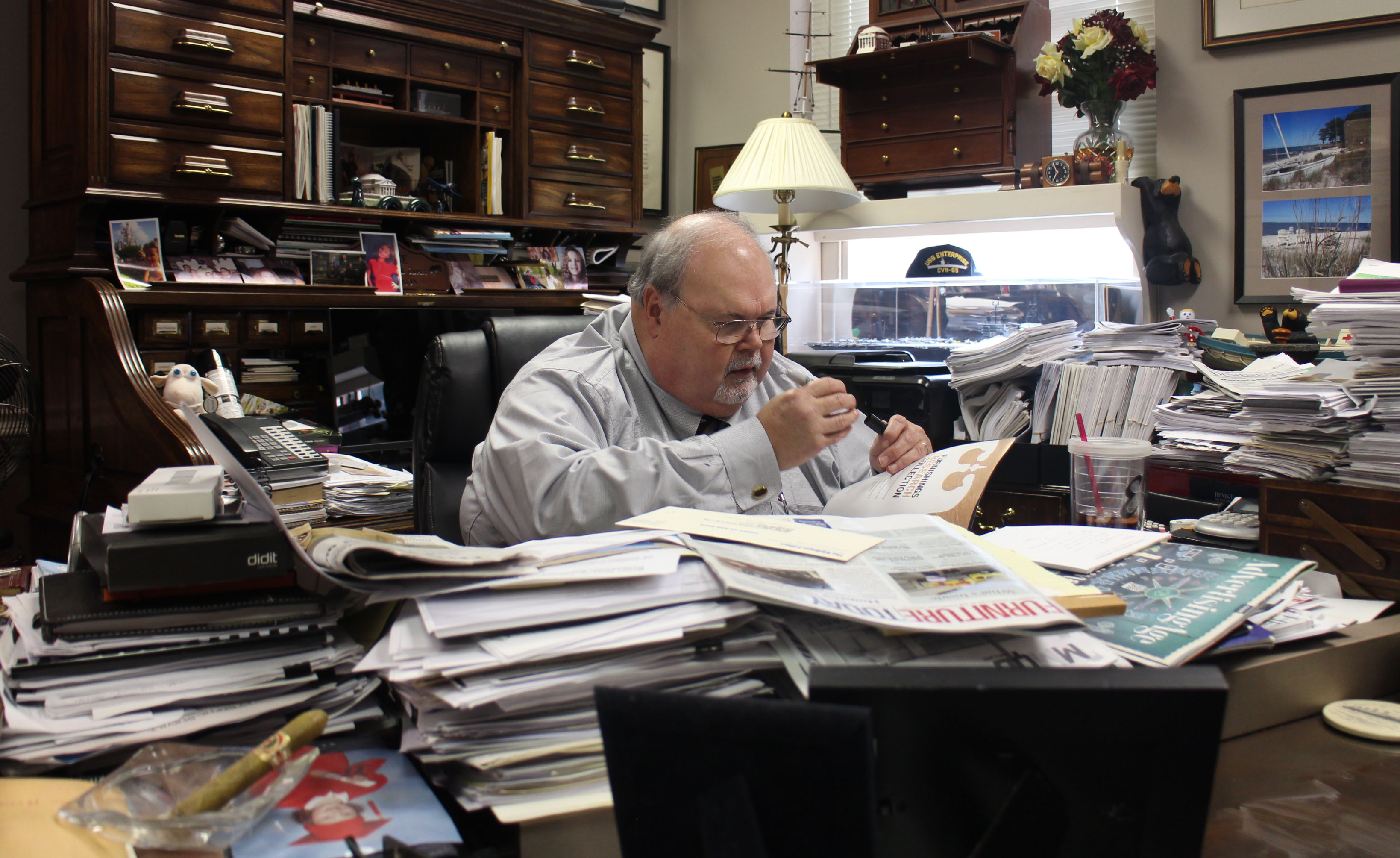
Jerry Epperson’s furnishings and mattress industry analysis is used by some of the country’s biggest investment banks.
If you’ve ever been shopping for a mattress, you likely conducted at least a few hours of research before heading off to make a purchase.
That Saturday in a strip mall pales in comparison to the work put in by Jerry Epperson, a founding partner and managing director of local investment banking firm Mann, Armistead & Epperson.
The University of Virginia and College of William & Mary graduate has carved out a curious niche among his fellow analysts: he’s regarded as a world-renowned expert on the American furnishings and mattress industries, with his research used by the likes of Goldman Sachs, the U.S. State Department and the International Sleep Products Association.
Growing up 70 miles south of Richmond in the small town of Victoria, Epperson was surrounded by furniture and textile factories. It was in Victoria that Epperson met Bernard Lane, the heir to a furniture company in nearby Altavista. Through Lane, Epperson made contacts throughout the furnishings industry that he kept as an analyst at Wheat First Securities, Scott & Stringfellow, and, since 1991, at his firm’s well-furnished office at 119 Shockoe Slip.
Epperson recently made an appearance on the “Freakonomics Radio” podcast, hosted by Stephen Dubner and named after his popular book with economist Steven Levitt. Epperson offered industry data and a Dick Van Dyke reference in the episode, which explores the national clustering of mattress store locations.
BizSense sat down recently with Epperson to find out just what it means to have expertise in mattresses. The following is an edited transcript:
Richmond BizSense: How does one come to be known as the leading expert on the furnishings and mattresses industries?
Jerry Epperson: Well, when I got out of graduate school, Scott & Stringfellow allowed me to come in and be their furniture analyst. And at the time, we Baby Boomers were coming in 77 million strong; the generation just prior to us was less than 50 million. It was our segment that was coming in and driving things in the ‘70s. We had a couple years where new housing starts were well over 2 million, and now we’re having trouble getting to a million. It just was a boom time for housing, a boom time for young people starting out, and Levitz Furniture was a hot stock and a lot of the other furniture stocks went public. We did some [IPOs] at Scott & Stringfellow, Wheat First Securities in town did a lot, and I became one of many furniture analysts.
There was a recession late in ’73 and the furniture industry suffered terribly. And the reason was, we had an inventory excess in retail. There were a lot of explanations for it, but the industry suffered. And a lot of the analysts just sort of gave up on the industry. And I woke up one day and I was the only person left. I’m not only the best furniture analyst in the world; I’m also the worst at the same time.
RBS: Since starting in the businesses, what has been the biggest change to the industries you study?
JE: If you go back to the ’70s, there were only two places you could go to buy mattresses and furniture: department stores or furniture stores. Why? They were the only two places you could go to get consumer credit to finance the purchase and that had home delivery. Today? You can buy furniture just about anywhere. Costco sells furniture. Big Lots sells a lot of furniture. You know, I’m expecting gas stations to start selling furniture. The distribution channels have changed, and that’s put different pressures on furniture stores.
The other thing that’s happened is, as we’ve gone more and more toward imports, it has worked to strengthen the larger retailers because they’re buying directly overseas and buy big container loads. That has worked to the detriment of smaller stores.
RBS: How would you assess Richmond’s furniture and mattress markets?
JE: We have our hometown retailer, Haynes, and Haynes does a fantastic job. I wish they got more credit for how creative their advertising is. Their prices are very good and their merchandise is as up-to-date as anywhere else.
On the mattress side, you’ve got a mix of everything from the biggest, Mattress Firm, to some more locally-owned companies.
RBS: What’s the best way for consumers to shop for a mattress?
JE: You can’t buy a mattress based on the price. There’s not a clear correlation. One of the most difficult things to do is lay on a mattress for one minute and figure out if that’s going to be right for you in the longer term. Know when you go into a mattress store if you’ve been comfortable on a softer mattress or a firmer mattress, and talk about the technologies that go in them now.
RBS: How long have you had your current mattress?
JE: I’ve had the current mattress since the first of April. Because we were moving, we got a new set of mattresses and a new electric bed instead of bringing the old mattress we had for 15 years.
RBS: Wait, you had the same mattress for that long?
JE (smiling): Made by Custom Comfort by Winn.
RBS: What kind of mattress is your new one?
JE: I am right now sleeping on my first foam mattress. And I like it. I’ve always had innersprings before, so I’m learning. But my wife likes it, and therefore I like it.

Jerry Epperson’s furnishings and mattress industry analysis is used by some of the country’s biggest investment banks.
If you’ve ever been shopping for a mattress, you likely conducted at least a few hours of research before heading off to make a purchase.
That Saturday in a strip mall pales in comparison to the work put in by Jerry Epperson, a founding partner and managing director of local investment banking firm Mann, Armistead & Epperson.
The University of Virginia and College of William & Mary graduate has carved out a curious niche among his fellow analysts: he’s regarded as a world-renowned expert on the American furnishings and mattress industries, with his research used by the likes of Goldman Sachs, the U.S. State Department and the International Sleep Products Association.
Growing up 70 miles south of Richmond in the small town of Victoria, Epperson was surrounded by furniture and textile factories. It was in Victoria that Epperson met Bernard Lane, the heir to a furniture company in nearby Altavista. Through Lane, Epperson made contacts throughout the furnishings industry that he kept as an analyst at Wheat First Securities, Scott & Stringfellow, and, since 1991, at his firm’s well-furnished office at 119 Shockoe Slip.
Epperson recently made an appearance on the “Freakonomics Radio” podcast, hosted by Stephen Dubner and named after his popular book with economist Steven Levitt. Epperson offered industry data and a Dick Van Dyke reference in the episode, which explores the national clustering of mattress store locations.
BizSense sat down recently with Epperson to find out just what it means to have expertise in mattresses. The following is an edited transcript:
Richmond BizSense: How does one come to be known as the leading expert on the furnishings and mattresses industries?
Jerry Epperson: Well, when I got out of graduate school, Scott & Stringfellow allowed me to come in and be their furniture analyst. And at the time, we Baby Boomers were coming in 77 million strong; the generation just prior to us was less than 50 million. It was our segment that was coming in and driving things in the ‘70s. We had a couple years where new housing starts were well over 2 million, and now we’re having trouble getting to a million. It just was a boom time for housing, a boom time for young people starting out, and Levitz Furniture was a hot stock and a lot of the other furniture stocks went public. We did some [IPOs] at Scott & Stringfellow, Wheat First Securities in town did a lot, and I became one of many furniture analysts.
There was a recession late in ’73 and the furniture industry suffered terribly. And the reason was, we had an inventory excess in retail. There were a lot of explanations for it, but the industry suffered. And a lot of the analysts just sort of gave up on the industry. And I woke up one day and I was the only person left. I’m not only the best furniture analyst in the world; I’m also the worst at the same time.
RBS: Since starting in the businesses, what has been the biggest change to the industries you study?
JE: If you go back to the ’70s, there were only two places you could go to buy mattresses and furniture: department stores or furniture stores. Why? They were the only two places you could go to get consumer credit to finance the purchase and that had home delivery. Today? You can buy furniture just about anywhere. Costco sells furniture. Big Lots sells a lot of furniture. You know, I’m expecting gas stations to start selling furniture. The distribution channels have changed, and that’s put different pressures on furniture stores.
The other thing that’s happened is, as we’ve gone more and more toward imports, it has worked to strengthen the larger retailers because they’re buying directly overseas and buy big container loads. That has worked to the detriment of smaller stores.
RBS: How would you assess Richmond’s furniture and mattress markets?
JE: We have our hometown retailer, Haynes, and Haynes does a fantastic job. I wish they got more credit for how creative their advertising is. Their prices are very good and their merchandise is as up-to-date as anywhere else.
On the mattress side, you’ve got a mix of everything from the biggest, Mattress Firm, to some more locally-owned companies.
RBS: What’s the best way for consumers to shop for a mattress?
JE: You can’t buy a mattress based on the price. There’s not a clear correlation. One of the most difficult things to do is lay on a mattress for one minute and figure out if that’s going to be right for you in the longer term. Know when you go into a mattress store if you’ve been comfortable on a softer mattress or a firmer mattress, and talk about the technologies that go in them now.
RBS: How long have you had your current mattress?
JE: I’ve had the current mattress since the first of April. Because we were moving, we got a new set of mattresses and a new electric bed instead of bringing the old mattress we had for 15 years.
RBS: Wait, you had the same mattress for that long?
JE (smiling): Made by Custom Comfort by Winn.
RBS: What kind of mattress is your new one?
JE: I am right now sleeping on my first foam mattress. And I like it. I’ve always had innersprings before, so I’m learning. But my wife likes it, and therefore I like it.
